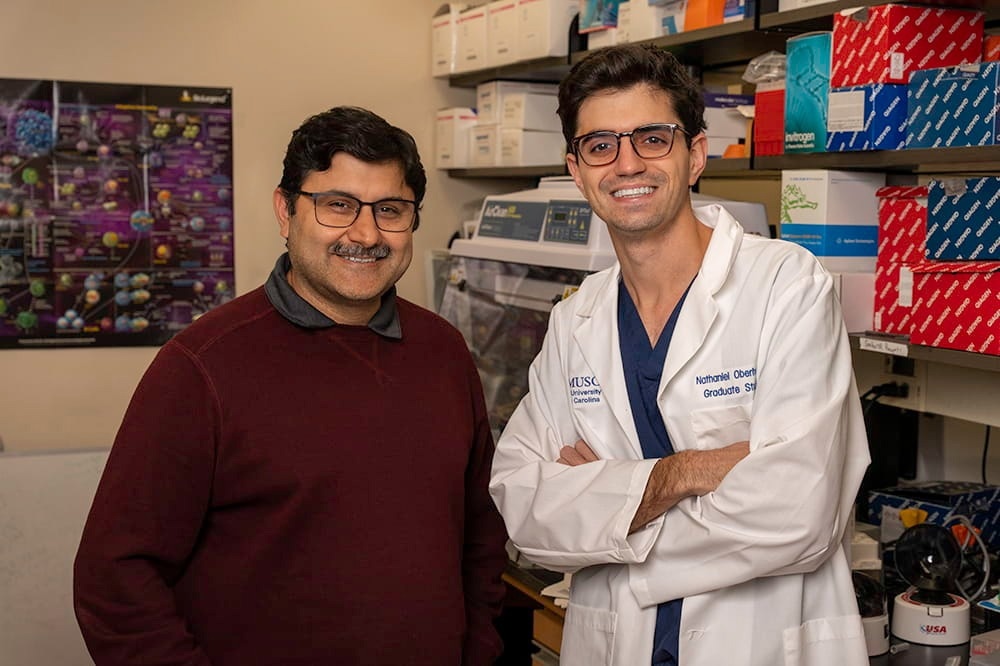The Golgi apparatus modifies, sorts, and packages proteins to be sent to their final destinations, whether within or outside the cell.
 Nate Oberholtzer, right, worked in Shikhar Mehrotra, Ph.D.'s lab while pursuing his Ph.D. He's finished that portion of his education and is completing his last two years of medical school, with the goal of a career in oncology. Image Credit: Clif Rhodes
Nate Oberholtzer, right, worked in Shikhar Mehrotra, Ph.D.'s lab while pursuing his Ph.D. He's finished that portion of his education and is completing his last two years of medical school, with the goal of a career in oncology. Image Credit: Clif Rhodes
It is a core function but little studied in cancer immunology, especially when compared to other organelles like the mitochondria or endoplasmic reticulum.
So we were interested in looking a little bit more at the Golgi apparatus. It is an important organelle. How is it being changed or what is its role in T-cells in terms of fighting cancer?”
Nathaniel Oberholtzer, Medical University of South Carolina
It turns out that the ability of T-cells to eliminate cancer cells is closely related to the Golgi apparatus's normal function. Knowing how a signaling axis reduces Golgi stress and permits it to function correctly suggests a potential new therapeutic target scientists may investigate to fortify T-cells.
Furthermore, Oberholtzer's work demonstrates how the Golgi may be employed as a biomarker to identify the most potent T-cells for immunotherapy.
Oberholtzer, as the First Author, Mehrotra, as the Senior Author, and a group of Hollings scientists published the study in the journal Science Advances.
The immune system's T-cells can destroy cancer cells. CAR-T cells are T-cells that have undergone laboratory modification to target proteins on the surface of a person's cancer cells. Every patient receives a unique batch of CAR-T cells.
The antagonistic tumor microenvironment can “exhaust” T-cells and CAR-T cells. To prolong their ability to combat cancer, Mehrotra's lab investigates methods to strengthen these cells.
The whole tumor microenvironment is conducive for the tumor itself, but not for the other cells which are trying to get in there.”
Shikhar Mehrotra, Study Co-Leader, Cancer Biology & Immunology Research Program, MUSC Hollings Cancer Center
Mehrotra is also the Scientific Director of the Center for Cellular Therapy in the MUSC College of Medicine.
Similar to humans, cells are under constant stress from both mechanical stress from movement and stress from unbalanced metabolic responses. Temporary stress might be beneficial. Exercise that puts muscles under stress makes them stronger, and brief stress on cells can cause a reaction that makes them stronger in the long run.
“But if this stress stays there, which it does in the tumor microenvironment, the cells are just in continuous stress, and that will then lead to a very different phenotype and death,” Mehrotra said.
However, the researchers discovered that hydrogen sulfide treatment of the Golgi apparatus produced T-cells that could withstand more stress.
Hydrogen sulfide is a gaseous signaling molecule present in pretty much all mammalian cell types. Typically, it is a byproduct of different cellular processes, but it is actually been shown to have really important signaling roles as well. It can modify proteins through a process called sulfhydration, where it modifies cysteine residues and can change their activity.”
Nathaniel Oberholtzer, Medical University of South Carolina
Oberholtzer discovered that this sulfhydration process protects an oxidative environment by altering a protein called Prdx4 within the Golgi apparatus.
“When you have the stressors that the tumor microenvironment puts on T-cells, you get a disruption, or fragmentation, of the Golgi apparatus where it essentially is not able to do its job. Hydrogen sulfide protects against that disruption,” Oberholtzer said.
Investigating this protective effect prompted the researchers to examine the Golgi system in greater detail on its own.
“Essentially, if you just use the Golgi apparatus as a simple marker, if T-cells have a lot of Golgi versus less, the ones that have more Golgi are much more robust at killing tumor cells and controlling tumors,” Oberholtzer explained.
The researchers classified T-cells based on the quantity of Golgi they contained using cell sorting technologies at the Flow Cytometry & Cell Sorting Shared Resource at Hollings. The labels Golgi-hi and Golgi-lo were applied to the top and bottom 30%, respectively.
“Basically, all the cells which are expressing high Golgi have a very different phenotype. They are less exhausted, and they are much more potent in controlling tumors,” Mehrotra said.
According to this preclinical research, separating T-cells into Golgi-hi and Golgi-lo and then reinfusing a patient with only the Golgi-hi cells would increase the likelihood of tumor control.
Oberholtzer said, “Right now, we are working on doing some validation studies in the Center for Cellular Therapy to potentially be able to start a clinical trial to see if that has a translational ability as well.”
When the tumor microenvironment puts all of the organelles in a cell under stress, more research is also required to comprehend the function of Golgi stress.
Source:
Journal reference:
Oberholtzer, N., et al. (2024) H 2 S-Prdx4 axis mitigates Golgi stress to bolster tumor-reactive T cell immunotherapeutic response. Science Advances. doi.org/10.1126/sciadv.adp1152.